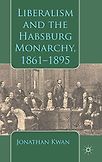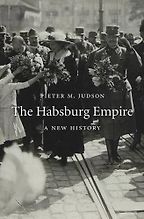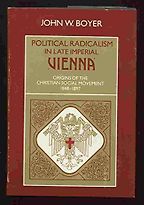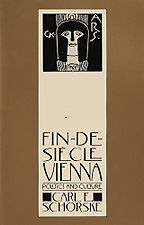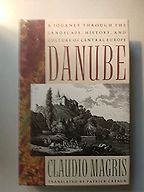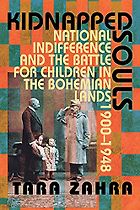To start we had better define exactly what we’re talking about: The Austrian and the Austro-Hungarian Empire in the long 19th century, up to the empire’s fall at the end of World War I. Before we get to the books, can you just set the scene in terms of time and place, and why it’s interesting to study this period of Austrian history?
The region is extremely rich and diverse, with many overlapping identities and cultures and peoples—I find it fascinating. If you had lived in the nineteenth century, it would have been absolutely normal to hear many different languages, to interact with many different people who had different religions, different backgrounds as well as people moving onwards, such as migration to America. What I like about the region, I suppose, is this fluidity.
Over the course of the nineteenth century, the Habsburg Empire witnessed a combination of turbulence and stability. The turbulence comes at the start with the French Revolution and Napoleon, in the middle with the 1848-49 revolutions, then at the end with World War I. You see these changes in the actual structure of the Empire as attempts were made to deal with the course of events and the diversity of peoples and traditions.
At the start, there was the fundamental challenge of the French Revolution and of Napoleon, who occupied Vienna twice. For centuries the Habsburgs had monopolised the title of Holy Roman Emperor and, in addition, had ruled a collection of contiguous lands in Central Europe; some of which were in the Holy Roman Empire—like Bohemia—and some of which were not, like Hungary. In 1805 Napoleon wiped these arrangements away, and Austria had to adapt, eventually leading to a Habsburg princess, Marie-Louise, marrying Napoleon. Already in 1804, with the writing on the wall, the Habsburg territories had been renamed the Austrian Empire, which didn’t really have a historical precedent.
Five Books interviews are expensive to produce. If you're enjoying this interview, please support us by donating a small amount.
Once Napoleon had gone, there was a period of stability under Metternich, and Austria largely dominated Central Europe and northern Italy. The 1848-49 revolutions opened many possibilities and questions, and the Empire had to adapt again, especially in the wake of the wars of 1859 with Piedmont-Sardinia and France, then 1866 with Prussia. These two defeats and the unresolved legacy of the Hungarian revolution in 1848-49 led to the formation of Austria-Hungary in 1867.
I’d say there are two factors which I find interesting. First is the state—its structures and the rulers and how they adapted to these changing fortunes. Second, the peoples and their interaction with other peoples, with state structures, with the rulers, and with events. I think those two factors are very important in this region. I’ll talk about these in relation to Pieter Judson’s book.
On that note, let’s turn to the books you’ve chosen on the Austro-Hungarian Empire. The title of Pieter Judson’s book is The Habsburg Empire: A New History. Tell us more about it.
I think Judson’s book sums up a generation of revisionist history. What many scholars have been looking for is a new narrative history that encompasses the revisionist history of the past few decades. The older historiography had said that nationalism tore the monarchy apart. Revisionist historians, on the other hand, say that nationalism had many different functions and went in many different directions. For example, it could be loyalist towards the empire. It could be mildly reformist while accepting the emperor. And small numbers of radicals could contemplate independence in a crisis situation, like World War I.
Judson’s book provides a summation of recent scholarship within an overarching narrative of the monarchy. He does this by combining those two factors, which I mentioned before; namely, the imperial institutions (including the emperor) and the relationship with the peoples. Judson argues for a constant dialogue between the two, involving negotiation, adjustment, adaptation, and ultimately, acceptance and recognition. He explores that relationship in a lot more depth than older books, which really stressed the development of an antagonistic relationship between imperial structures and peoples. I think Judson really highlights the interaction, the contact and the mutual respect that existed.
Does the book give a fresh explanation for the collapse of the Austro-Hungarian Empire? Does it lie within World War I, or does he give it deeper chronological roots?
In my opinion, the empire’s collapse can be located within World War I and even late on in the war—say 1917/1918—when you have starvation, subordination under the German Empire, Wilson’s fourteen points and hitherto unimaginable difficulties in fighting. World War I was a totalizing event, circumstances were fundamentally different, and there had to be fundamental change. That had happened with Napoleon – and the Empire adapted. The question with World War I is, could the Austro-Hungarian Empire have stayed together? Judson’s book, while acknowledging the inefficiencies and difficulties, portrays a vibrant, flourishing, if disputative, monarchy at the outset of the war.
There’s been a lot of scholarship recently due to the various anniversaries of the war. Much of it shows that, in general, the army and many of the peoples of the monarchy were loyal to the monarch, really right to the end.
Let’s go on to the second book, John Boyer’s Political Radicalism in Late Imperial Vienna: Origins of the Christian Social Movement, 1848-1897. Why have you chosen this one? And what story does this book tell?
This book is an outstanding example of historical scholarship. John Boyer is a professor at the University of Chicago and has been editor of the Journal of Modern History for decades. The book delves deeply into local Viennese politics and you have a real sense of a changing Vienna as well as how politics actually functioned on the ground. The story Boyer tells is of the growth and development of the political Catholic movement (Christian Socialism) and especially its charismatic leader, Karl Lueger, who is known as the first anti-Semitic mayor in Europe.
What Boyer shows is the rational, reasoned building and growth of a political movement. Previous historiography understood Lueger as a populist politician who used anti-Semitism for populist ends, but Boyer shows the many interrelated, interlocking reasons for the success of Lueger. It was not just ideology—though that played a part. Rather, the movement was built from the ground up. There was dissatisfaction among many of the artisans, there was mobilization by the lower priests in suburbs, there was the articulation of ‘Christian values’ in relation to capitalism and the changing world. Another factor was disappointment with the promise of liberalism. Lueger brought all of these elements together, and built it into an incredible electoral machine.
“The book delves deeply into local Viennese politics and you have a real sense of a changing Vienna”
He did it by appealing to what Boyer calls the unity of the Bürgertum (middle-class citizens), which was first glimpsed as a political force in 1848. At that time there had been a hope that fundamental reform was possible. Boyer argues that the liberals betrayed that vision to some extent—being quite elitist and relying on property and taxes to slow and prevent democratic participation and social reform. What Lueger did was to unite the Bürgertum, to get the artisans, the priests and democrats, then the bureaucrats and teachers, and, finally, the propertied middle class—who were all dissatisfied with liberalism—and to slowly combine them into a party underneath the umbrella of Christian values. Lueger was extremely successful and popular in doing that. There is still a statue of him on the Ringstrasse.
And does the book suggest he built this movement while being loyal to the Emperor and to the Austrian Empire, did he?
Absolutely, he was very loyal. In fact, the emperor was reluctant to name Lueger as mayor, because of his anti-Semitism. One of Lueger’s deputies had to become mayor for a year. Then, following a series of elections in which the Christian Social party performed better and better, finally, in 1897 the emperor named Lueger as mayor.
I’d just like to add one point about John Boyer’s book and how it represents anti-Semitism as being used instrumentally. Boyer, I believe, sees Lueger’s anti-Semitism as a political tool (one of many) that was used to unite support for the Christian Social movement. But I think, to some extent, this de-emphasizes the corrosive effects of anti-Semitism. The 1890s and 1900s were changing political times with populist rhetoric, the rise of mass politics, and a growing socialist movement. Presenting anti-Semitism as a political tool underestimates the devastating effects it had on political norms in the monarchy.
Let’s move on to Carl Schorske’s Fin-de-Siècle Vienna: Politics and Culture.
Schorske deals with some of the issues that come up in John Boyer’s book, but in a very different way. There is, for example, an essay juxtaposing Lueger, Georg von Schönerer (a pan-German, racist populist) and Theodor Herzl (the founder of Zionism) under the rubric of “Politics in a New Key.” But where John Boyer is meticulous on local politics, party formation, policies and politicians, Schorske generally addresses the period from the perspective of high culture. So there are famous essays on Gustav Klimt, Arthur Schnitzler, Hugo von Hofmannsthal and Arnold Schoenberg, the architect Otto Wagner, Sigmund Freud. It’s a dazzling array of intellectual talent.
It is a very famous book and what Schorske shows is how incredibly fertile Vienna was at the turn of the century. The book has created, in the popular mind, an idea of ‘Vienna 1900.’ For example, a recent play by Tom Stoppard has an episode set in Vienna around 1900. There are also many memoirs, especially from members of Jewish families, about Vienna and the rich intellectual life of the city in that period.
I’ve just read Stefan Zweig’s autobiography, The World of Yesterday, which offers up a similar hymn to Vienna at that time.
Yes, it’s a beautiful book. I did think about putting it in here as one of my five recommendations. Zweig’s sense of Vienna is a retrospective view from an Austrian Jew in the late 1930s who now feels excluded from European culture and European history. He makes the case that in the old days of the monarchy, the Jews had been part of European culture and could participate in it.
Yes, they had been attacked by Lueger and had faced many difficulties. But, nevertheless, many felt at home in European culture, they loved it, and the Emperor protected their place within it. Zweig sees it as a glorious time (Gustav Mahler was running the opera, for example) with a highly developed cultural and intellectual life. From his memoirs, it seemed to be a time when everyone knew everyone.
This is a point Schorske emphasizes, that somehow these figures all knew each other and interacted. There is a cliché that ‘Vienna is a village’. It is quite a small town. Schorske’s book is very powerful because it has a central thesis that holds the essays together; namely, that the background to Vienna 1900 was the failure or collapse of liberalism and the flight to culture of the middle classes. Now, I don’t agree entirely with Schorske’s thesis, but the book provides a central thread running through the detailed and deep analyses of different thinkers, writers and intellectuals.
Next up is Tara Zahra, Kidnapped Souls: National Indifference and the Battle for Children in the Bohemian Lands, 1900-1948. I read a brief synopsis and it sounds extraordinary. Tell us about it.
I included this because I think it is the most innovative and conceptually daring book on the Habsburg monarchy and its successors to emerge in the last few years. It investigates nationalism, not through its dreams and plans, or within a national narrative of eventual independence, but by looking at on-the-ground, specific, concrete instances.
How did it work within the Empire, and then subsequently in the interwar period and then during World War II? The first 100 pages are on the monarchy and how nationalism functioned, not necessarily in politics, but in reality with everyday people. She outlines a tripartite structure of the state administration for schools and education, the national activists who wanted their language in the schools, and then the people and how the people reacted.
“It investigates nationalism, not through its dreams and plans, or within a national narrative of eventual independence, but by looking at on-the-ground, specific, concrete instances”
Her book demonstrates a number of points. First, the state tried to be a neutral arbiter. Second, the national activists were sometimes despairing at the indifference of the general people. Third, among the general public, many were actually quite flexible about nationalism. They were not fundamentalist or essentialist. For example, there are many instances of Czech families who for pragmatic, careerist, opportunistic reasons sent their kids to the local German-speaking school. The attitude was basically: the children already have Czech so it would be good if they were totally fluent in German, too. Of course, the Czech activists said, ‘You can’t do that, the children are Czechs, they should go to the Czech school.’ This stance often provoked considerable pressure from activists because, according to law, if a Czech school existed for a number of years—thus showing a demand and need—the municipality had to take over funding of that school.
So the book reveals the interaction of activists, the state and the people. In the older historiography nationalism was dealt with in more general terms, whereas Zahra’s book delves into the actual details and case studies of its operation.
I feel like whenever I’ve read about the Austro-Hungarian Empire in the 19th century, Czech nationalism always seems to be the strongest in the empire. Does this book suggest as much? Were the Czechs a particular difficulty, or were they just a large group?
It was a difficulty because of the imperial structure of Austro-Hungarian dualism. There was a sense that the Czechs felt aggrieved by the fact that Hungary was granted autonomy and had its particular traditions recognized when the monarchy became Austria-Hungary in 1867. The Czechs believed that they deserved autonomy because of their historical rights associated with the Kingdom of Bohemia.
Recent books have emphasized that nationalism is contingent and contextual. It’s different for almost everybody. It’s also different for almost every locality. It’s different over time. There are people who are not particularly concerned about national matters. I think this is one of the big movements in the historiography—not to essentialise nationalism, but to look at the specific context with the specific actors. In addition, historians need to acknowledge if there are non-national factors involved, such as religion, or maybe even personal motivations—careers, for example.
For the Czechs, there were some difficulties that are fundamental in relation to governing from Vienna. One is that the proportion of Czech speakers to German speakers in Bohemia was, I think, about 2:1 – 62% to 38%, depending on the particular census. Moravia was similar—about 70% to 30%. So you have a lot of German speakers in these regions, who had traditionally been extremely powerful in the administration, in the military, in the economy, in the intellectual world. In sum, there was a very strong, very powerful, motivated German minority, which looked to Vienna for protection.
“Recent books have emphasized that nationalism is contingent and contextual. It’s different for almost everybody”
The second point is that in the time of Maria Theresa and Joseph II, Bohemia had been incorporated more within the overarching state of Austria than Hungary. Hungary was always difficult to control for the Habsburgs. It had a history of rebellions and was very protective of its local autonomy. It could be argued that Bohemia was incorporated within the structures of the monarchy much more than Hungary.
A third factor is that the emperor and the elites of the centre were very reluctant to change the 1867 dualist system after it had functioned for a long time. Around the turn of the century, there were fears of excessive demands from the Czechs, violence in the streets, and Germans in Bohemia who would not accept any concessions. So after a few decades there was a certain reluctance to upset the system and reopen questions about the basic structure of the monarchy. It should be kept in mind, though, that there were many attempts at administrative reform and reconciliation such as the 1905 Moravian Compromise.
Let’s go on to the last book. This is by Claudio Magris and it’s called Danube: A Journey through the Landscape, History and Culture of Central Europe. What does this tell us about the Austro-Hungarian Empire?
This is a strange but wonderful work. It is certainly not a standard history. It is not a travel book. It’s digressive, discursive and elusive. It’s metaphorical. It’s obscure. It’s rambling. But I think it gives a sense of living and experiencing Central Europe. In the course of the book and its meander along the Danube, you go through layers and layers of the past. You go through different landscapes, and you meet different people through time. Magris discusses thinkers, writers and intellectuals. You really get a sense of the richness, diversity and interconnectedness of Central Europe.
Magris is a professor of German and a writer of fiction based in Trieste. Trieste is such an interesting place. It was part of the Habsburg Monarchy from the 14th century right up until 1918. There is an Italian-speaking, very powerful majority in the city, but there are also many Slovenians, both in the city and in the surrounding countryside, especially. Magris, who was born and grew up in Trieste, writes in Italian but does not look to Italy—to Rome and Florence, for instance—for his primary cultural inspiration. No, he looks north. He loves German culture. He loves Central Europe and its past. You get that sense from the book.
Is he essentially travelling through the landscape and talking about it?
He uses travel on the Danube as a device for digressions and meditations on many different topics. Sometimes the sections seem randomly strung together. There is no real structure. To a large extent, it is a series of disconnected vignettes. But it also somehow functions as a whole.
Get the weekly Five Books newsletter
I suppose the structure is going down the Danube, but he includes many people who had minimal contact with the lands along the Danube. Kafka, Celine and Celan are all discussed, though they only have tangential, fleeting relations to the river. Magris meditates on people, works, episodes, intersections—with a certain nostalgia. In many respects it is clear-eyed as well, especially in relation to the tragedies of war and the Holocaust. You get a sense that the world he is looking for has disappeared. He has regrets about this, similar to those expressed by Zweig in his autobiography, The World of Yesterday.
When was it published?
In the 1980s. It sold very well in Europe; I recently read an article where the publishers did not quite know how to market it in the English-speaking world. It is a strange book and very intellectual. Some people may say it is pretentious but it is also extremely beautiful. I think, in the end, it was marketed as a travel book. To some extent it is. The framing of the book is him as a narrator going to a conference in Germany, close to the origin of the Danube, and then it sort of follows the Danube, with many digressions. Ultimately, it really is not a travel book. What sort of book is it? I don’t know, but I do know that I enjoyed it!
Five Books aims to keep its book recommendations and interviews up to date. If you are the interviewee and would like to update your choice of books (or even just what you say about them) please email us at [email protected]

